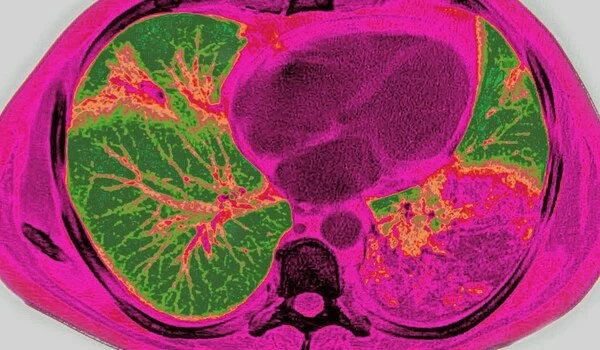Cystic fibrosis is a condition in which thick, sticky mucus accumulates in the lungs, digestive tract, and other parts of the body. It is one of the most prevalent chronic lung diseases in children and adolescents. It is a potentially fatal condition.
SARS-CoV-2 and pneumococcus pathogens can cause severe pneumonia. If the airways become clogged, the patient is at risk of developing acute respiratory distress syndrome. The molecular mechanisms that cause fluid accumulation in the lungs have now been discovered by Charité — Universitätsmedizin Berlin researchers. This also led to the discovery of a possible new therapy: In their laboratory experiments, a cystic fibrosis drug proved effective, raising hopes that it could be used to treat pneumonia regardless of the pathogen that caused it. The study has been published in the journal Science Translational Medicine.
The most common cause of fluid buildup in the lungs is pneumonia. This condition, known as pulmonary edema, causes parts of the airspaces to fill with fluid rather than air, preventing them from performing their function of exchanging gases. Patients have trouble breathing and their bodies are depleted of oxygen. The condition is known as acute respiratory distress syndrome, or ARDS.
“Despite cutting-edge medical procedures, approximately 40% of ARDS patients die in intensive care. The issue is that antibiotics, antivirals, and immune modulation therapies are rarely effective enough” Prof. Dr. Wolfgang Kuebler, Director of Charité’s Institute of Physiology, led the study.
“That’s why we took a very different approach in our study. Instead of focusing on the pathogen, we focused on strengthening the barrier function of the blood vessels in the lungs.” This makes sense, as they are the source of the fluid in pulmonary edema. The lung vessels become permeable, allowing fluid from the blood to flow into the surrounding tissue and thereby flood the airspaces.
We discovered that inhibiting CFTR causes a molecular cascade that eventually causes the blood vessels in the lung to leak. So CFTR does play a very important role in the development of pulmonary edema.
Dr. Lasti Erfinanda
But what exactly is the source of this? What are the molecular mechanisms at work? Prof. Kuebler’s Charité research team set out to answer these questions. They experimented on cells, lung tissue, and isolated lungs. The study focused on the CFTR chloride channel, which scientists know is mostly found in our airway mucosal cells. It is important in keeping our mucus thin so that it can drain easily. The researchers have now demonstrated for the first time that CFTR is present in cells in the blood vessels of the lungs and that its presence is significantly reduced in pneumonia.
The researchers used an inhibitor to block the channel and controlled the number of chloride ions in the cells to determine what role CFTR plays in the pulmonary vessels and what happens at the molecular level when the chloride channel is lost. They then used immunofluorescence imaging, a specialized imaging technique:
“We discovered that inhibiting CFTR causes a molecular cascade that eventually causes the blood vessels in the lung to leak,” says Dr. Lasti Erfinanda, who also works at the Institute of Physiology and is the study’s lead author. “So CFTR does play a very important role in the development of pulmonary edema.”

According to the findings of the study, the loss of CFTR causes chloride to accumulate in cells because it is no longer transported out of them. Excess chloride causes signaling, which results in an uncontrolled flow of calcium into cells via a calcium channel.
“The increased calcium concentration then causes the vascular cells to contract, similar to the effect calcium has on muscle cells,” Prof. Kuebler explains. “This causes gaps between the cells, allowing fluid to leak out of the blood vessels. Chloride channels are thus critical in maintaining the pulmonary vessels’ barrier function.”
The research team then addressed another question: How could they attenuate or prevent the pneumonia-induced loss of chloride channels in the pulmonary vessels? To answer this, the researchers used a therapeutic agent that is classed as a CFTR modulator and is currently used to treat cystic fibrosis. In cystic fibrosis patients, a genetic mutation prevents the CFTR chloride channel from working properly in the mucosal cells of the airways, resulting in very viscous mucus.
“Ivacaftor is a drug that increases the chances of the chloride channel opening, which helps the mucus to flow through the airways,” says Dr. Erfinanda. “We wanted to see if it would also have a positive effect on the cells in the blood vessels of the lungs.”
Ivacaftor did make the chloride channels more stable: it caused less degradation in the channels than is normally caused by inflammatory processes in the lung. Experiments on animal models revealed the same effect: ivacaftor treatment increased the likelihood of surviving severe pneumonia, reduced lung injury, and resulted in much milder symptoms and a much better overall condition than a placebo.
“We weren’t expecting it to work so well,” Prof. Kuebler says. “We hope that our findings will pave the way for clinical trials to evaluate the efficacy of CFTR modulators in patients with pneumonia. If this promising pathogen-independent therapy makes it into clinical practice, it has the potential to benefit a large number of patients and prevent pneumonia from becoming life-threatening – even when the pathogen is unknown.”
















